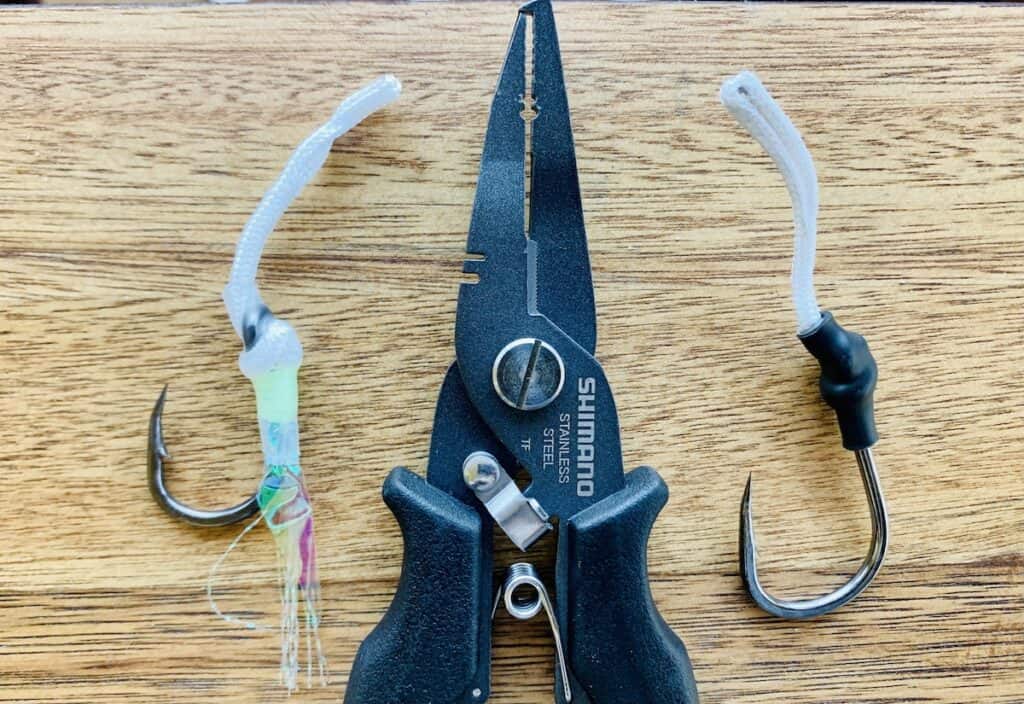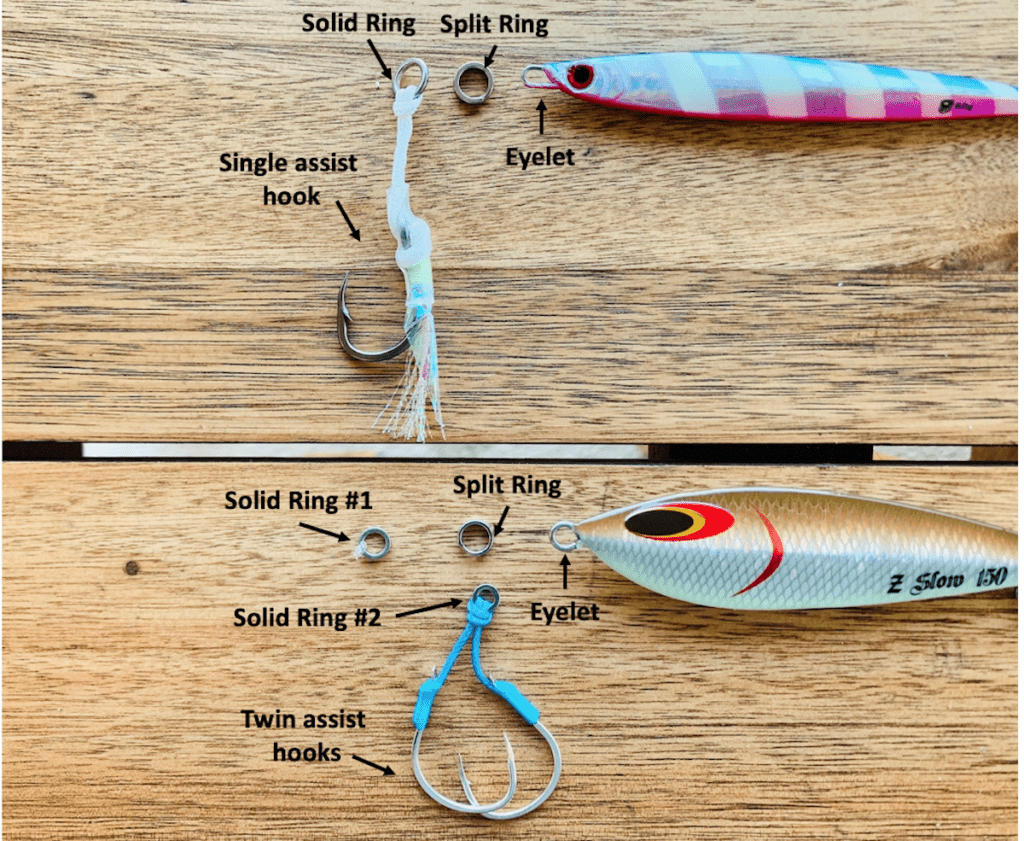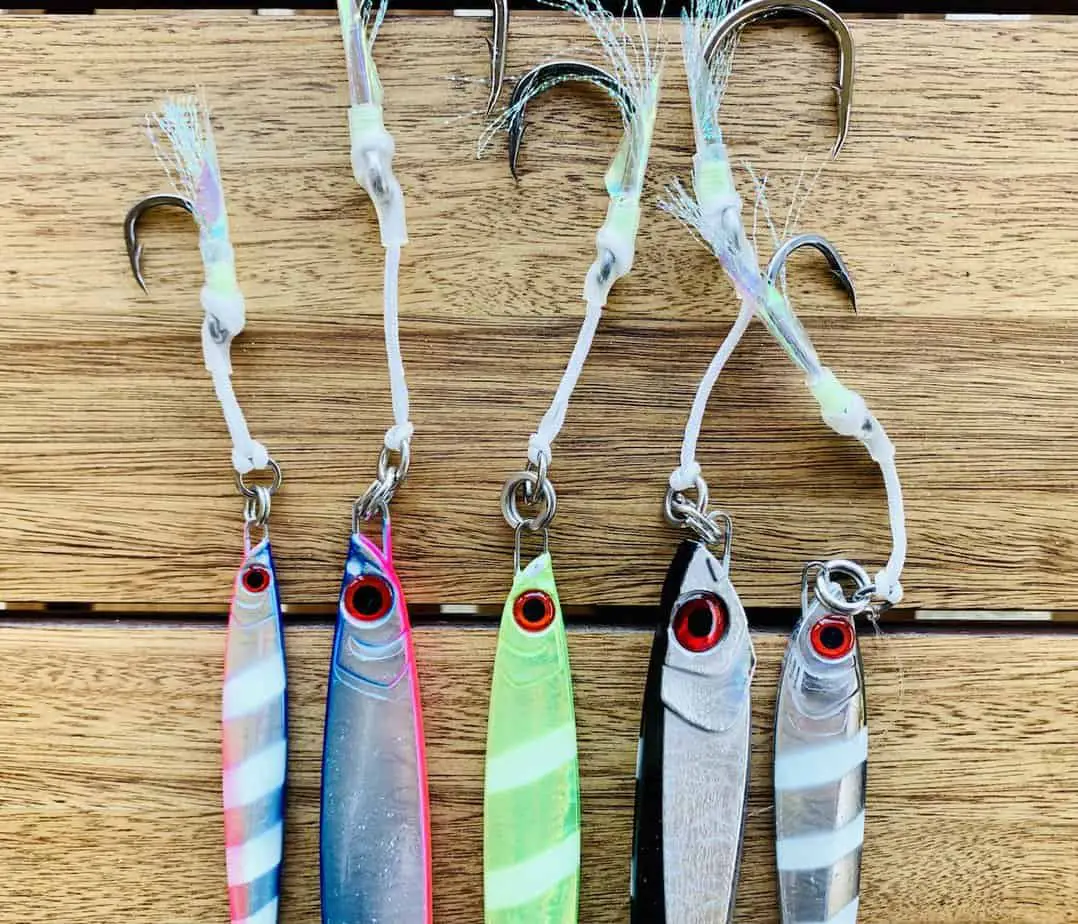What is a Speed Jig?
A speed jig is a hard metal fishing lure which has it’s hooks attached to the eyelet with a heavy cord, rather than the hook built into the lure. The design of the jig is such that it falls quickly to the bottom of the ocean when allowed to drop in freespool. The primary action of the jig occurs on the way up when it usually darts back and forth erratically. They are painted flashy colors to reflect light and attract fish from further away.
A high speed vertical jigging technique is used with speed jigs. When using this method, anglers will drop the jig to the ocean floor with the reel in freespool. Once it hits bottom, the angler starts to do a pattern of twitching, jerking, and pausing while quickly retrieving. As the retrieval is happening, the jig is darting through the water and imitating a fleeing and healthy baitfish. This is irresistible to pelagic species and they’ll often strike hard when they strike.
The jigs are designed to be heavy, long, and slender to get down to depth quickly. They also tend to have sharp tapers and angles around the top of the jig, which makes it dart around. Some of these jigs come pre-rigged with heavy gauge hooks, and others do not.
Anglers looking to try high speed vertical jigging will need to buy some jigs. I recommend the Ocean Tackle International Degen jig and the Ocean Tackle International Ricochet jig. They’re very affordable and come pre-rigged with one heavy gauge hook attached to the top eyelet with a split ring. These jigs are great for beginners, and they even sell a kit to help you quickly get a variety of sizes on hand.
Knowing what size speed jig to use is actually pretty simple. You’ll need 1 gram of lure weight for every 1 foot of water depth. So if you’re fishing in 150 ft of water, you’ll want a 150 gram jig. Sometimes you can go heavier if the current is strong. If you go too light with a strong current, the water will carry your jig away and you’ll lose a lot of the action on the retrieval because it’s critical that the jig is retrieved straight up.
How to Work a Speed Jig
A key thing to remember when working a speed jig is to pace yourself. It is called speed jigging because of how fast the angler must retrieve the heavy jig. As you might imagine, it can get tiring pretty quickly.
To work a speed jig properly, the angler should first drop the jig to the ocean floor while the reel is in freespool. Once the fisherman feels bottom, the clutch is engaged and the retrieval process starts. The angler should twitch the rod up while retrieving very quickly. Then pause, and repeat the twitch and retrieve. The jig is designed to dart in different directions as it comes up, and to properly imitate a healthy fleeing baitfish, the whole process is fast.
The process requires no slack in the line. This means the jig needs to be heavy enough on the way down to avoid a bow in the line. By keeping the line taut, the jig can act as it was designed for a longer period of time, improving your chances of success.
I recommend letting yourself try different retrieval patterns. You can twitch slightly off to one side, or vary the number of times you pause, for example. You may find different patterns work best for different species. Once you find what works, stick with it!
Hooks for Speed Jigs
The hooks are important in speed jigging. In this technique, the fish will strike hard because they’re trying to catch a fast and healthy “baitfish”. This requires heavy line strength,
heavy power rods, and definitely heavy gauge hooks. My article Top 7 Saltwater Jigging Rods discusses more about choosing the right rod for jigging.
A light wire hook would most certainly bend when stuck by a strong and fast pelagic. Some anglers worry about not being able to penetrate the fish with a heavy gauge hook. For this reason, I recommend making sure you pick one with an ultra sharp point.
Also, think about the way that the hook is attached. It is attached to a solid ring which is directly attached to the leader line. The jig is attached to that same solid ring with a split ring. This makes it possible to lose a jig without losing a fish, and it also means the weight of the hook will pull in the opposite direction of the fish when struck, causing the weight of the jig to help the hook penetrate the fish.
Although you’ll want the biggest hook you can, the right size is dependent on the jig. The hook should be slightly narrower than the width of the jig.

The assist hook is rigged with a heavy cord. The cord length should be long enough for the hook to reach to about the middle of the jig. You can rig a hook on the top eyelet and a hook on the bottom, but just be careful to make sure the cord lengths don’t cause the hooks to tangle with each other. Some fisherman will add the second hook on the bottom to avoid missing a fish for a short strike.
Since the right size can vary based on the size of the jig, you’ll need to keep a variety of hook sizes with different cord lengths on hand. Each pack of assist hooks comes with a few hooks and runs close to $10. You can very likely save money by learning to tie the cord yourself.
How to Rig Speed Jigs
Speed jigs are rigged a certain way because of the hard strikes they have to endure. They are frequently rigged with at least one heavy gauge hook on the top eyelet, and sometimes a second heavy gauge hook on the bottom eyelet.
You can rig with all the way up to 4 hooks, but when doing this you should be mindful that the heavy hooks could be affecting the action of the jig. Its more common for these heavy gauge hooks to be attached as only one at each eyelet, hence the reason they are rigged with cord individually and not as a twin pair.
A speed jig is rigged by tying the leader to the solid ring which holds the hook. This can be done with either a Palomar or Clinch knot. Then the jig is attached to the same solid ring via a split ring attached to the jig’s eyelet. You can see how the center of the rigging is the hook’s solid ring. This is done on purpose to avoid a split ring being in the main point of stress. The fish will strike hard in speed jigging and attaching to a split ring could mean a split ring opening up and a lost fish.

This is different from the rigging for slow pitch jigging. In slow pitch jigging, the leader line is attached to a solid ring or swivel, then attached to a split ring. That split ring is attached to the eyelet of the jig and also attached to a second solid ring which holds the twin assist hooks. In this rigging, the split ring is the main point of stress, but it’s acceptable because slow pitch jigging mimics a dying baitfish and invokes a much softer strike. The risk of a split ring opening up is much lower in slow pitch jigging. To learn more about the difference between speed jigging and slow jigging, read my article Speed Jigging vs Slow jigging: is Speed the Only Difference?
To do this rigging, you’ll need to have a pair of split ring pliers. Before I bought a pair, I was using whatever I could find to try to open the split ring, and let me warn you, it is not easy trying to open up a 300 lb split ring without the right tool!
I hope this article helps you understand speed jigs. Tight lines, y’all!
Recent Posts
Fat Cow Jig Strips: The Ultimate Bucktail Jig Upgrade for Surf Fishing
As discussed in my previous article, "Surf Fishing with Bucktail Jigs: Ultimate Guide for Beach Anglers," bucktail jigs are a staple in any surf angler's tackle box, offering a versatile way to catch...
In my previous article, "Surf Fishing with Bucktail Jigs: Ultimate Guide for Beach Anglers," I introduced you to the bucktail jig and discussed how versatile of a lure it is for catching a wide range...

